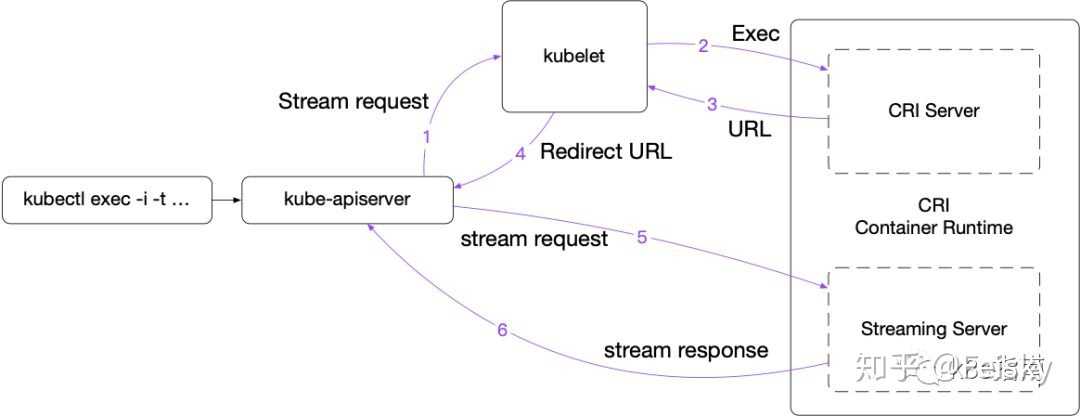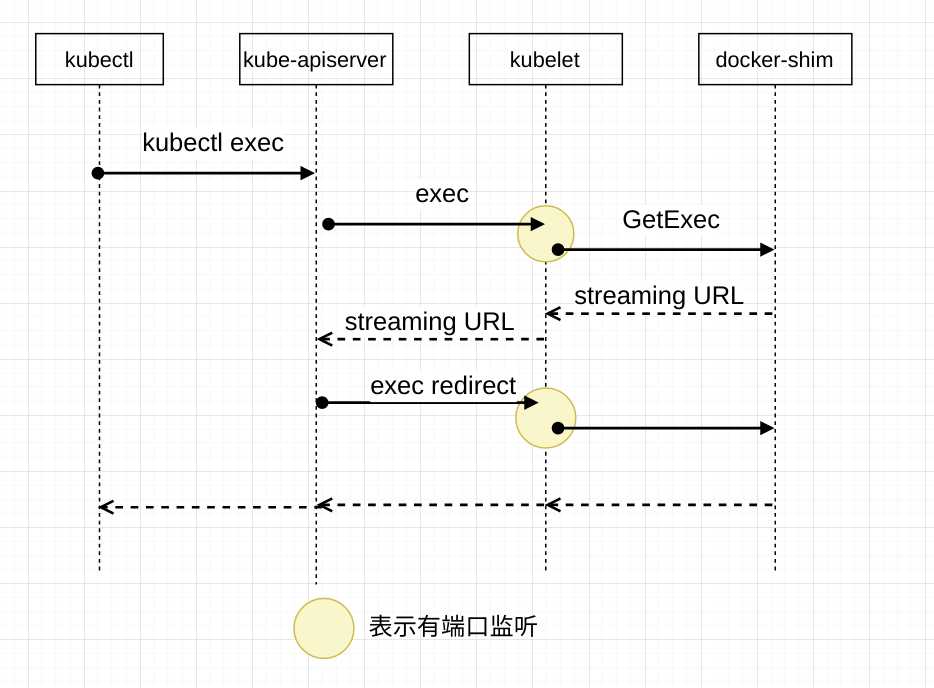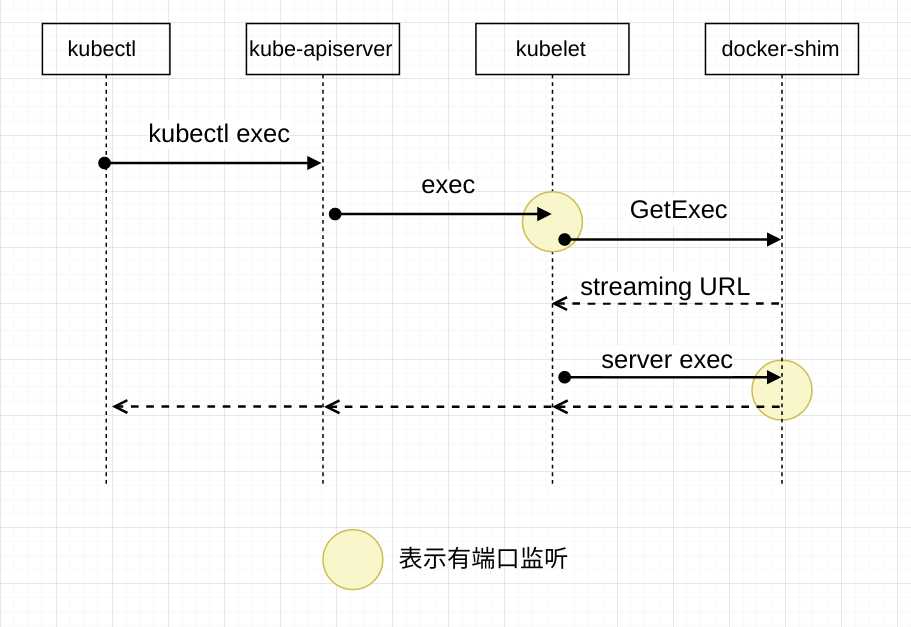标签:because validate 代码 process requests response not iad fail
基于kuebrnetes v1.17
简单来说,一个完整的streaming请求如下:

在 v1.10 及更早版本中,容器运行时必需返回一个 API Server 可直接访问的 URL(通常跟 Kubelet 使用相同的监听地址);而从 v1.11 开始,Kubelet 新增了 --redirect-container-streaming(默认为 false),默认不再转发而是代理 Streaming 请求,这样运行时可以返回一个 localhost 的 URL。通过 Kubelet 代理的好处是由 Kubelet 处理与 API server 通信之间的请求认证。
可以看到kubelet在处理exec请求的时候分为两步, 1. 首先获取streaming URL,2. 随后根据该URL建立流式请求。
kubelet在启动时会初始化一个serve,注册好对应的handler, exec的handler如下:
ws = new(restful.WebService)
ws.
Path("/exec")
ws.Route(ws.GET("/{podNamespace}/{podID}/{containerName}").
To(s.getExec).
Operation("getExec"))
ws.Route(ws.POST("/{podNamespace}/{podID}/{containerName}").
To(s.getExec).
Operation("getExec"))
ws.Route(ws.GET("/{podNamespace}/{podID}/{uid}/{containerName}").
To(s.getExec).
Operation("getExec"))
ws.Route(ws.POST("/{podNamespace}/{podID}/{uid}/{containerName}").
To(s.getExec).
Operation("getExec"))
s.restfulCont.Add(ws)
所有的路径最后都由getExec来进行处理:
// getExec handles requests to run a command inside a container.
func (s *Server) getExec(request *restful.Request, response *restful.Response) {
params := getExecRequestParams(request)
streamOpts, err := remotecommandserver.NewOptions(request.Request)
if err != nil {
utilruntime.HandleError(err)
response.WriteError(http.StatusBadRequest, err)
return
}
pod, ok := s.host.GetPodByName(params.podNamespace, params.podName)
if !ok {
response.WriteError(http.StatusNotFound, fmt.Errorf("pod does not exist"))
return
}
podFullName := kubecontainer.GetPodFullName(pod)
url, err := s.host.GetExec(podFullName, params.podUID, params.containerName, params.cmd, *streamOpts)
if err != nil {
streaming.WriteError(err, response.ResponseWriter)
return
}
if s.redirectContainerStreaming {
http.Redirect(response.ResponseWriter, request.Request, url.String(), http.StatusFound)
return
}
proxyStream(response.ResponseWriter, request.Request, url)
}以上代码可以看出,首先调用host.GetExec获取URL,然后判断是否开启重定向,如果开启则进行重定向,否则直接代理请求到该streaming URL。这里host对象对应的实现其实就是kubelet, 我们看下GetExec的实现:
// GetExec gets the URL the exec will be served from, or nil if the Kubelet will serve it.
func (kl *Kubelet) GetExec(podFullName string, podUID types.UID, containerName string, cmd []string, streamOpts remotecommandserver.Options) (*url.URL, error) {
container, err := kl.findContainer(podFullName, podUID, containerName)
if err != nil {
return nil, err
}
if container == nil {
return nil, fmt.Errorf("container not found (%q)", containerName)
}
return kl.streamingRuntime.GetExec(container.ID, cmd, streamOpts.Stdin, streamOpts.Stdout, streamOpts.Stderr, streamOpts.TTY)
}这里只是继续调用streamingRuntime的GetExec方法,streamingRuntime是个interface,具体的实现是kubeGenericRuntimeManager
// GetExec gets the endpoint the runtime will serve the exec request from.
func (m *kubeGenericRuntimeManager) GetExec(id kubecontainer.ContainerID, cmd []string, stdin, stdout, stderr, tty bool) (*url.URL, error) {
req := &runtimeapi.ExecRequest{
ContainerId: id.ID,
Cmd: cmd,
Tty: tty,
Stdin: stdin,
Stdout: stdout,
Stderr: stderr,
}
resp, err := m.runtimeService.Exec(req)
if err != nil {
return nil, err
}
return url.Parse(resp.Url)
}继而调用了runtimeService.Exec方法, 此处runtimeService根据CRI创建的remoteRuntimeService,简单来说就是对应CRI server的client端
// Exec prepares a streaming endpoint to execute a command in the container, and returns the address.
func (r *RemoteRuntimeService) Exec(req *runtimeapi.ExecRequest) (*runtimeapi.ExecResponse, error) {
ctx, cancel := getContextWithTimeout(r.timeout)
defer cancel()
resp, err := r.runtimeClient.Exec(ctx, req)
if err != nil {
klog.Errorf("Exec %s '%s' from runtime service failed: %v", req.ContainerId, strings.Join(req.Cmd, " "), err)
return nil, err
}
if resp.Url == "" {
errorMessage := "URL is not set"
klog.Errorf("Exec failed: %s", errorMessage)
return nil, errors.New(errorMessage)
}
return resp, nil
}调用cri client请求cri server端,在这里server端就是docker shim (docker Service对象)
// Exec prepares a streaming endpoint to execute a command in the container, and returns the address.
func (ds *dockerService) Exec(_ context.Context, req *runtimeapi.ExecRequest) (*runtimeapi.ExecResponse, error) {
if ds.streamingServer == nil {
return nil, streaming.NewErrorStreamingDisabled("exec")
}
_, err := checkContainerStatus(ds.client, req.ContainerId)
if err != nil {
return nil, err
}
return ds.streamingServer.GetExec(req)
}调用dockerService.StreamingSerer的GetExec方法,streamingServer的所有方法都定义在:pkg/kubelet/server/streaming/server.go里
func (s *server) GetExec(req *runtimeapi.ExecRequest) (*runtimeapi.ExecResponse, error) {
if err := validateExecRequest(req); err != nil {
return nil, err
}
token, err := s.cache.Insert(req)
if err != nil {
return nil, err
}
return &runtimeapi.ExecResponse{
Url: s.buildURL("exec", token),
}, nil
}可以看到这里只是返回一个简单的token组合成的url, 之所以生成一个token是因为用户的命令中可能包含各种各样的字符,各种长度的字符,需要格式化为一个简单的token。 该token会缓存在本地,后面真正的exec请求会携带这该token,通过该token找到之前的具体请求。
在获取到该exec真正的URL后,就需要通过该URL来获取真正的数据了。为该URL提供服务的sever一般位于CRI的实现之中,例如docker shim会创建一个streamingServer来提供服务。
各个运行时 streaming server 的处理框架都是类似的,kublet为了方便各runtime实现CRI接口,提供了统一的包,位于:pkg/kubelet/server/streaming/server.go。 各种底层runtime只需要实现其中的steaming.Runtime接口就可以简单创建一个streamingServer:
// Runtime is the interface to execute the commands and provide the streams.
type Runtime interface {
Exec(containerID string, cmd []string, in io.Reader, out, err io.WriteCloser, tty bool, resize <-chan remotecommand.TerminalSize) error
Attach(containerID string, in io.Reader, out, err io.WriteCloser, tty bool, resize <-chan remotecommand.TerminalSize) error
PortForward(podSandboxID string, port int32, stream io.ReadWriteCloser) error
}目前kubelet内置了docker runtime的实现:dockershim,在dockershim中streaming.Runtime的实现结构体为streamingRuntime:
type streamingRuntime struct {
client libdocker.Interface
execHandler ExecHandler
}
var _ streaming.Runtime = &streamingRuntime{}其中docker client作为成员函数,以便后面请求docker获取数据。
NOTE
注意区分kubelet中各种runtime的定义,说实话各种runtime确实挺乱的,我们需要明确各种Runtime是定义在哪个scope下的,streaming.Runtime是个interface, 位于pkg/kubelet/server/streaming/server.go,用来定义流处理请求的所需要的动作。streamingRuntime是dockershim对streaming.Runtime interface的具体实现,位于pkg/kubelet/dockershim/docker_streaming.go,该结构体为private的。 另一个比较容易混淆的是pkg/kubelet/container/runtime.go (俗称kubecontainer)中的StreamingRuntime, 该interface为public的,用来定义GetExec/GetAttach/GetPortForward接口
利用该streaming.Runtime就可以创建streamingServer了:
// NewServer creates a new Server for stream requests.
// TODO(tallclair): Add auth(n/z) interface & handling.
func NewServer(config Config, runtime Runtime) (Server, error) {
s := &server{
config: config,
runtime: &criAdapter{runtime},
cache: newRequestCache(),
}
if s.config.BaseURL == nil {
s.config.BaseURL = &url.URL{
Scheme: "http",
Host: s.config.Addr,
}
if s.config.TLSConfig != nil {
s.config.BaseURL.Scheme = "https"
}
}
ws := &restful.WebService{}
endpoints := []struct {
path string
handler restful.RouteFunction
}{
{"/exec/{token}", s.serveExec},
{"/attach/{token}", s.serveAttach},
{"/portforward/{token}", s.servePortForward},
}
// If serving relative to a base path, set that here.
pathPrefix := path.Dir(s.config.BaseURL.Path)
for _, e := range endpoints {
for _, method := range []string{"GET", "POST"} {
ws.Route(ws.
Method(method).
Path(path.Join(pathPrefix, e.path)).
To(e.handler))
}
}
handler := restful.NewContainer()
handler.Add(ws)
s.handler = handler
s.server = &http.Server{
Addr: s.config.Addr,
Handler: s.handler,
TLSConfig: s.config.TLSConfig,
}
return s, nil
}
在NewServer中会注册对应的handler来处理/exec/{token}类接口。这里exec的handdler为ServerExec方法:
func (s *server) serveExec(req *restful.Request, resp *restful.Response) {
token := req.PathParameter("token")
cachedRequest, ok := s.cache.Consume(token)
if !ok {
http.NotFound(resp.ResponseWriter, req.Request)
return
}
exec, ok := cachedRequest.(*runtimeapi.ExecRequest)
if !ok {
http.NotFound(resp.ResponseWriter, req.Request)
return
}
streamOpts := &remotecommandserver.Options{
Stdin: exec.Stdin,
Stdout: exec.Stdout,
Stderr: exec.Stderr,
TTY: exec.Tty,
}
remotecommandserver.ServeExec(
resp.ResponseWriter,
req.Request,
s.runtime,
"", // unused: podName
"", // unusued: podUID
exec.ContainerId,
exec.Cmd,
streamOpts,
s.config.StreamIdleTimeout,
s.config.StreamCreationTimeout,
s.config.SupportedRemoteCommandProtocols)
}进而调用ServeExec方法:
// ServeExec handles requests to execute a command in a container. After
// creating/receiving the required streams, it delegates the actual execution
// to the executor.
func ServeExec(w http.ResponseWriter, req *http.Request, executor Executor, podName string, uid types.UID, container string, cmd []string, streamOpts *Options, idleTimeout, streamCreationTimeout time.Duration, supportedProtocols []string) {
ctx, ok := createStreams(req, w, streamOpts, supportedProtocols, idleTimeout, streamCreationTimeout)
if !ok {
// error is handled by createStreams
return
}
defer ctx.conn.Close()
err := executor.ExecInContainer(podName, uid, container, cmd, ctx.stdinStream, ctx.stdoutStream, ctx.stderrStream, ctx.tty, ctx.resizeChan, 0)
if err != nil {
if exitErr, ok := err.(utilexec.ExitError); ok && exitErr.Exited() {
rc := exitErr.ExitStatus()
ctx.writeStatus(&apierrors.StatusError{ErrStatus: metav1.Status{
Status: metav1.StatusFailure,
Reason: remotecommandconsts.NonZeroExitCodeReason,
Details: &metav1.StatusDetails{
Causes: []metav1.StatusCause{
{
Type: remotecommandconsts.ExitCodeCauseType,
Message: fmt.Sprintf("%d", rc),
},
},
},
Message: fmt.Sprintf("command terminated with non-zero exit code: %v", exitErr),
}})
} else {
err = fmt.Errorf("error executing command in container: %v", err)
runtime.HandleError(err)
ctx.writeStatus(apierrors.NewInternalError(err))
}
} else {
ctx.writeStatus(&apierrors.StatusError{ErrStatus: metav1.Status{
Status: metav1.StatusSuccess,
}})
}
}
在remotecommandserver.ServeExec中调用了executer.ExecInContainer 方法, 该executer接口的实现是criAdapter, criAdapter只是Runtime的一个wrapper,真正调用的是Runtime.Exec, Runtime是个interface,我们来看下具体在dockershim中的实现:
func (r *streamingRuntime) Exec(containerID string, cmd []string, in io.Reader, out, err io.WriteCloser, tty bool, resize <-chan remotecommand.TerminalSize) error {
return r.exec(containerID, cmd, in, out, err, tty, resize, 0)
}
// Internal version of Exec adds a timeout.
func (r *streamingRuntime) exec(containerID string, cmd []string, in io.Reader, out, errw io.WriteCloser, tty bool, resize <-chan remotecommand.TerminalSize, timeout time.Duration) error {
container, err := checkContainerStatus(r.client, containerID)
if err != nil {
return err
}
return r.execHandler.ExecInContainer(r.client, container, cmd, in, out, errw, tty, resize, timeout)
}
其中execHandler是在初始化streamRuntime的时候定义的NativeExecHandler, 可以看到是直接调用libdocker api与docker进行交互
// NativeExecHandler executes commands in Docker containers using Docker's exec API.
type NativeExecHandler struct{}
func (*NativeExecHandler) ExecInContainer(client libdocker.Interface, container *dockertypes.ContainerJSON, cmd []string, stdin io.Reader, stdout, stderr io.WriteCloser, tty bool, resize <-chan remotecommand.TerminalSize, timeout time.Duration) error {
done := make(chan struct{})
defer close(done)
createOpts := dockertypes.ExecConfig{
Cmd: cmd,
AttachStdin: stdin != nil,
AttachStdout: stdout != nil,
AttachStderr: stderr != nil,
Tty: tty,
}
execObj, err := client.CreateExec(container.ID, createOpts)
if err != nil {
return fmt.Errorf("failed to exec in container - Exec setup failed - %v", err)
}
// Have to start this before the call to client.StartExec because client.StartExec is a blocking
// call :-( Otherwise, resize events don't get processed and the terminal never resizes.
//
// We also have to delay attempting to send a terminal resize request to docker until after the
// exec has started; otherwise, the initial resize request will fail.
execStarted := make(chan struct{})
go func() {
select {
case <-execStarted:
// client.StartExec has started the exec, so we can start resizing
case <-done:
// ExecInContainer has returned, so short-circuit
return
}
kubecontainer.HandleResizing(resize, func(size remotecommand.TerminalSize) {
client.ResizeExecTTY(execObj.ID, uint(size.Height), uint(size.Width))
})
}()
startOpts := dockertypes.ExecStartCheck{Detach: false, Tty: tty}
streamOpts := libdocker.StreamOptions{
InputStream: stdin,
OutputStream: stdout,
ErrorStream: stderr,
RawTerminal: tty,
ExecStarted: execStarted,
}
err = client.StartExec(execObj.ID, startOpts, streamOpts)
if err != nil {
return err
}
ticker := time.NewTicker(2 * time.Second)
defer ticker.Stop()
count := 0
for {
inspect, err2 := client.InspectExec(execObj.ID)
if err2 != nil {
return err2
}
if !inspect.Running {
if inspect.ExitCode != 0 {
err = &dockerExitError{inspect}
}
break
}
count++
if count == 5 {
klog.Errorf("Exec session %s in container %s terminated but process still running!", execObj.ID, container.ID)
break
}
<-ticker.C
}
return err
}
至此整个处理流程就结束了。
其实整个流程也比较简单,就是各个runtime shim实现一个kubelet定义好的iterface streaming.Runtime, 然后就可以利用kubelet提供的一个统一的工具package简单实现一个streaming server。该server负责两件事情,1. getExec: 首先根据用户请求的命令返回一个带有token的url,重定向用户请求到该url。2. serveExec: 随后真正提供exec的服务,该exec调用各个runtime shim的具体实现.。
RedirectContainerStreaming在前面提到,如果kubelet开启了RedirectContainerStreaming,则kubelet会将streaming URL返回给apiserver, 随后apiserver会重定向到该streaming URL。这样设计是为了避免所有的流式请求都经过kubelet对kubelet造成压力, 但是从另外一方面考虑,这样做的缺点是无法使用kubelet的认证功能。
那接下来我们仔细探究一下该参数所起到的真正作用,kubelet中默认runtime是docker,所以这里的研究对象就是dockershim:
一: 如果将RedirectContainerStreaming参数设置为true 则返回的URL类似于/cri/exec/aRbQe4pn,可以看到这里的域名默认是没有hostname的,则重定向时默认重定向到原来的hostname,即kubelet监听的hostname。 所以其实dockershim作为默认的runtime时,设置RedirectContainerStreaming为true并不会有什么本质的区别,对kubelet的性能影响并没有减少,因为所有的流处理还是经过了kubelet。
上述/cri/exec/aRbQe4pn这个路径在kubelet server中的对应handler为criHandler。 kubelet启动的时候会对该criHandler进行赋值,将dockerService赋值给criHandler (此处docker service其实就是docker shim)
if crOptions.RedirectContainerStreaming {
klet.criHandler = ds
}
dockerService中的实现为:
func (ds *dockerService) ServeHTTP(w http.ResponseWriter, r *http.Request) {
if ds.streamingServer != nil {
ds.streamingServer.ServeHTTP(w, r)
} else {
http.NotFound(w, r)
}
}
简单调用了streamingSever的ServeHTTP方法:
func (s *server) ServeHTTP(w http.ResponseWriter, r *http.Request) {
s.handler.ServeHTTP(w, r)
}
在streamingServer会根据注册的handler进行处理请, 这就又回到了我们上面提到的第二步: 提供streaming请求
整个workflow如下:

二: 如果设置RedirectContainerStreaming为false 则此时第一步获取到的streaming URL形如:http://127.0.0.1:36699/exec/8rYzmQK9。 可以看到这里是带有hostname的。 因为此时kubelet并不会将该URL返回给apiserver,会直接请求该URL进行代理,如此一来就可以通过127.0.0.1进行直接通信,这个localhost的端口必然是由docker shim来进行监听:
// Start initializes and starts components in dockerService.
func (ds *dockerService) Start() error {
ds.initCleanup()
// Initialize the legacy cleanup flag.
if ds.startLocalStreamingServer {
go func() {
if err := ds.streamingServer.Start(true); err != nil {
klog.Fatalf("Streaming server stopped unexpectedly: %v", err)
}
}()
}
return ds.containerManager.Start()
}
在dockerShim中调用了streamingServer的Start方法启动监听端口:
func (s *server) Start(stayUp bool) error {
if !stayUp {
// TODO(tallclair): Implement this.
return errors.New("stayUp=false is not yet implemented")
}
listener, err := net.Listen("tcp", s.config.Addr)
if err != nil {
return err
}
// Use the actual address as baseURL host. This handles the "0" port case.
s.config.BaseURL.Host = listener.Addr().String()
if s.config.TLSConfig != nil {
return s.server.ServeTLS(listener, "", "") // Use certs from TLSConfig.
}
return s.server.Serve(listener)
}通过启动一个监听在localhost的sever, 这就又回到了我们上面提到的第二步: 提供streaming请求
整个workflow如下:

仔细观察这两幅workflow图片的差别就会发现, RedirectContainerStreaming 在默认的dockershim中并没有实质的作用,此时还是建议将该值设置为false来提供流处理请求的认证功能。
Kubernetes 容器运行时演进
How does ‘kubectl exec‘ work?
标签:because validate 代码 process requests response not iad fail
原文地址:https://www.cnblogs.com/gaorong/p/11873114.html